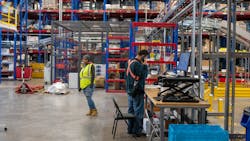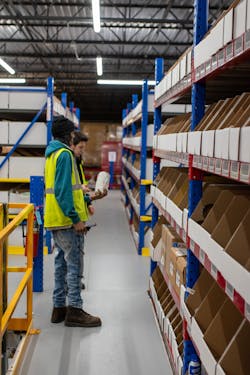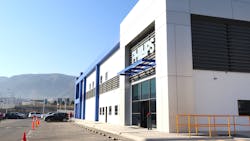The post-pandemic parts plan: Distributor and supplier solutions
The parts shortage that ran rampant during the COVID-19 pandemic has left deep scars in the commercial vehicle industry; wounds that are still being felt today. However, in a sink-or-swim environment like the one of 2020, shops, manufacturers, and suppliers alike learned how to adapt and keep society moving when no one else could. How did distributors and suppliers cope with shortages, and how are they preparing for the next global crisis?
Parts hell: A retrospective
Let’s recall how truly tumultuous the supply chain was just a few years ago.
Semiconductor shortages left newly built trucks dormant near their plants of origin, while a lack of raw materials due to widespread plant shutdowns in China (where the SARS-CoV-2 virus was first reported) kept relatively cheap parts from being made, and thus sidelined fleet assets. Furthermore, even when parts were manufactured and shipped across the Pacific, the port backlogs of 2021 kept containers from getting to shore.
“What we saw was just sporadic supply chain disruptions across a number of categories and raw materials,” said FleetPride’s Ken Clinchy, VP of digital e-commerce. “At times, it felt a little bit like whack-a-mole: As we fixed our supply chain on brake drums, now we’ve got plastic shortages—and you can’t get filters. It was sort of one thing after another.
“Nobody was safe from that,” he added. “And for fleets, it could mean missing a seal for a turbocharger, and they could have a truck down for six weeks.
You’re probably talking about a $40 to $50 piece that’s holding a $125,000 truck in a shop, costing thousands of dollars a day to not be running.” Service managers became battlefield commanders, deciding how to get at least a few wounded trucks back in the fight. That often meant cannibalizing parts.
“They rob Peter to pay Paul to keep that truck going,” Clinchy explained. “They would take a part from two or three trucks to keep one on the road. That happened quite frequently, and honestly, it even happened in some of our own shops.”
See also: Fleets share how they’ve endured truck, trailer equipment shortagesWhile that was the extreme survival method, more often fleets and shops would just simply need to expand their network and use their smartphone to order parts via ecommerce sites, as opposed to calling their usual representative.
“We definitely saw an uptick in digital usage from our customers, and not just in traditional channels—they were using non-traditional vendors,” FleetPride’s Gamble said. “Just anybody who could get them the part.”
This all ended up benefiting FleetPride, which launched its e-commerce site in October 2021, upgrading from a catalog format. The distributor now has more than 1 million parts and over 10 million cross-references. This is a 33% increase in parts and more than double the cross-references from July 2022. The site also recommends associated and alternative parts.
Overall, Clinchy said the company is “more agile” in helping fleets than before, “because we had to move so quickly during the pandemic to help our customers, and so it’s a muscle we really built out as an organization.”
Cummins-Meritor was already bulky in this department, with the MeritorPartsXpress ecommerce site maturing since its 2017 inception and the Uptime Services Group ready to offer emergency parts assistance to fleets. This positioned the OEM and aftermarket supplier to mitigate various issues, such as labor availability.
“MeritorPartsXpress is transactionally agnostic to labor disruptions as customers may place orders, schedule returns, and manage their core eligibility electronically,” explained Jason Soika, Cummins-Meritor GM of sales, N.A. aftermarket. “This provides a quick and effective solution for customers to order parts.”
Soika added fleets also learned that inexpensive parts from non-traditional suppliers would pass muster for secondary-cyle trucks, but not when prices ballooned to compensate for shipping costs.
“The direct sourcing competitive advantage offered by these suppliers evaporated when logistical expenses accelerated to never-before-seen levels,” Soika explained. “In many scenarios, buyers not only had to burden the inflated cost to import the products, but then had to navigate the domestic quagmire of port and transportation delays created by labor shortages.”
Distributor and supplier lessons learned: Growing and sharing
Some believe a crisis is a terrible thing to waste, and that’s true if you fail to learn from it. And that’s what the CV supply chain has been trying to do since the pandemic.
And according to Jim Pennig, VP of Business Development, VIPAR Heavy Duty, a healthy inventory from a mix of multiple suppliers for similar products was key to success during the pandemic.
“Those with proper inventory levels rode out the pandemic with record sales,” he said.He attributed this to an “increased level and detail of communication with our distributors, as well as with our supplier community supporting the VIPAR Heavy Duty network.”
The e-commerce functionality has also expanded to include more administrative and user options for shop management, which aids in reporting, compliance, quotes, and reducing rogue spend, the company said.
See also: Owner-operators express parts availability and other pain pointsIn custom cases, FleetPride can even offer a form of predictive ordering.
“We also connect digitally with many of our customers who are able to let us know ahead of time that they’re going to need this part on this date,” Clinchy said. “And they’ve got the part on their shelf before the truck ever breaks down.”
Gamble said fleets could help “forward deploy inventory” by informing their distributor of duty cycle, region, and where exactly the trucks will be domiciled.
The pandemic “forced” FleetPride to work closer with vendors, Gamble said. This includes sharing forecasts and data “with [FleetPride’s] best and most strategic vendor partners that allowed them to ramp up production and helped them balance their cost better.”
This has paid off, said OE partner Delco Remy.
“The resources being committed to providing holistic customer solutions in this digital environment is really incredible,” said Nick Chelman, national accounts manager for Delco Remy. “We are doing our part to provide all Delco Remy product information to support our customers in the field through the FleetPride efforts.”
In VIPAR’s sphere, sharing info allowed for “a consistent and accurate gauge of product availability and other forces impacting the supply chain,” so the network could respond appropriately, Pennig explained.
He stressed fleets should also develop a “B2B transactional relationship with a distributor [which] helps significantly with expediting parts availability and the order and delivery process.”
True success all comes down to transparency, according to Brad Williamson, director of parts marketing and stratgey at Daimler Truck North America. He noted in a panel at the Heavy Duty Aftermarket Dialogue (HDAD) event in January that suppliers did end up sharing more information with the OEM during the pandemic, and were “more human with each” and “more transparent” about production issues. This included updating DTNA when too many workers were out sick to meet production goals.“A lot of times before the pandemic, there was a little bit of keeping your guard up, and I really feel like a lot of our suppliers stepped up in being open,” he said.
Williamson said sharing data and information is “a two-way street,” and the OEM also has to communicate with suppliers. He added the pandemic proved “ecommerce is here to stay.” DTNA launched the Excelerator platform in 2020, succeeding Pinnacle Truck Parts. The site can search via VMRS codes, VIN, product name, or part number, and loops in inventory info from the entire Dealer Management System, including Alliance Parts DCs.
“We’ve got to get our dealers parts, so we can get our customers parts, so we can get trucks back on the road, and literally keep the world moving,” Williamson said.
Manufacturer lesson learned: Destination Mexico
America, and the rest of the world, found out the hard way that relying so much on exports from one country can lead to ruin when the steady flow of Chinese products simply stopped when the country locked down.
In December 2022, China ended its “zero COVID” policy. This relaxed stance led to 250 million COVID-19 infections in China during the first 20 days of that month, according to figures allegedly leaked from China’s National Health Commission. The world’s largest production base has roared back in manufacturing activity, but manufacturers’ confidence in China has been shaken.
“China has been a difficult place to do business in the last three years or so, since COVID really changed some of the assumptions that we had about the globalization that was taking place in the previous decade or so,” said Kent Jones, president of SAF-Holland’s Jones at HDAD. “We’re reevaluating many supply positions that were single-sourced in China, coming to us in the U.S. and into our company in Europe. It was highly disruptive to the supply chain.”
See also: Redwood Logistics expands Mexico presence to match nearshoring focus
His co-panelist, Jeffery Porter, president and CEO of Velvac Inc., a maker of medium- and heavy-duty truck, bus, and RV parts, concurred.
“In the last four or five years we’ve been trying to move as much of our component supply back to North America as possible,” Porter said, noting that geopolitical events have also added to the urgency.
Instead of looking east across the Pacific, the heavy-duty chassis component manufacturer has turned south of the border to Mexico.
Mexico already makes a substantial portion of North America’s commercial trucks —half, according to SAF’s Jones. This includes Freightliner, Kenworth, Navistar, and Peterbilt models. Nearshoring is also attractive as the United States-Mexico-Canada Agreement (USMCA) dictates that at least 75% of auto and truck parts automobiles be made in North America.
In March, SAF-Holland broke ground in Piedras Negras, located in Coahuila, Mexico, on a 158,000-sq.-ft. facility plant to manufacture fifth wheels and other components. That factory is expected to open in August.
“This investment allows us to better meet customer demand, delivering our fifth wheels more quickly to tractor manufacturers, dealers, and customers,” Jones stated after the groundbreaking. “The additional manufacturing space not only enables us to serve our customers better but provides for future growth.”
Nearshoring to Mexico has many benefits.
“When we’re looking at key factors that influence where to put your production capacity—like availability and cost of labor, proximity to customers, proximity to supply base—I think all of those arrows point to Mexico as being a really good choice,” Porter said.
Velvac’s main plant is in Reynosa, Mexico, a border town due south of San Antonio, Texas.
“That’s all allowed us to be more cost competitive; we’re more responsive to our customers and have better control over quality at the same time,” Porter said.
Rob Phillips, CEO of Phillips Industries and CEO and founder of Phillips Connect, the third panelist at that HDAD discussion, is one of the industry’s biggest proponents of Mexican manufacturing.
“We’re very bullish on Mexico: I’m a huge fan of the workers, the level of experience from the industry perspective,” he said. “The college system is spectacular. So, we don’t have labor issues—we have people that line up [for work].”
Phillips Industries already had been producing wire harnesses in Saltillo, Mexico, for over 15 years, and in March celebrated the grand opening of a new 500,000-sq.-ft. facility. In Q2 2023, Phillips expects to make about 20,000 truck parts—cables, air hoses, harnesses, lighting, and coils—per week for OEMs, up from 11,000. For the aftermarket, production will increase from 28,000 to 40,000 parts per week.
See also: 'Just getting warmed up': Phillips expands operations in Mexico
Phillips Connect is relocating its lines for trailer sensors and gateway devices to the company’s original plant on the same campus.
Phillips also shifted manufacturing from China to Southeast Asia and Australia. “We set up in Vietnam to avoid some of the tariffs that are plaguing us from the China side,” Phillips said. “But the reality is we’re looking at nearshoring. Everything is about moving closer, reducing inventories, improving quality levels and cycle times.”
With the supply chain moving in the right direction, the next time a global crisis happens, fleets should be able to focus more on trucks getting from Point A to B, and not out of the bay. Let’s just hope that’s not for a very long time.
This is Part Two of a two-part story on Fleet Maintenance, one of FleetOwner's sister publications. Read part one here.
About the Author
John Hitch
Editor
John Hitch is the editor-in-chief of Fleet Maintenance, providing maintenance management and technicians with the the latest information on the tools and strategies to keep their fleets' commercial vehicles moving. He is based out of Cleveland, Ohio, and was previously senior editor for FleetOwner. He previously wrote about manufacturing and advanced technology for IndustryWeek and New Equipment Digest.



